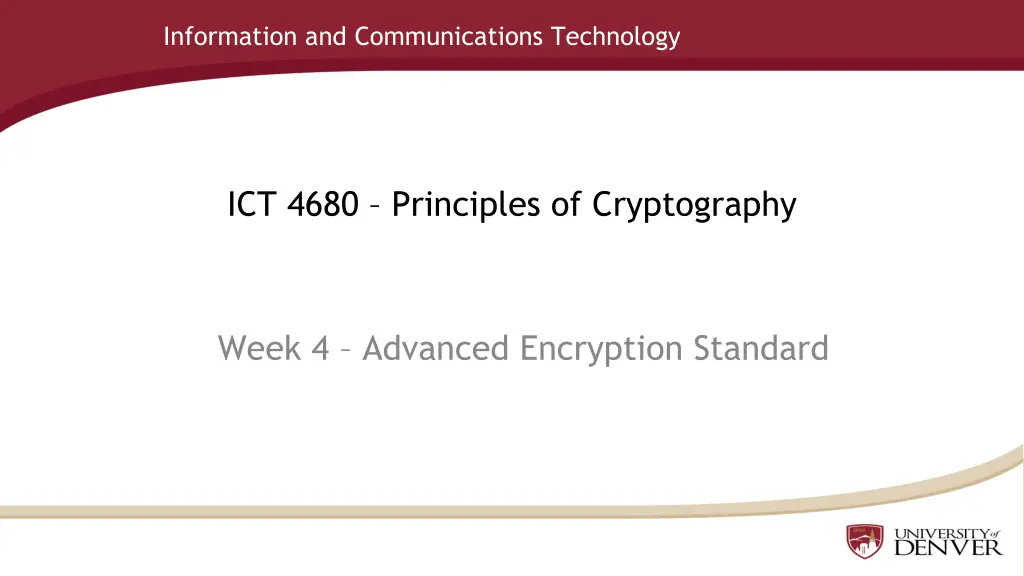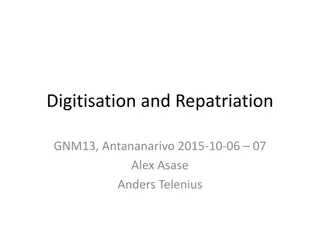
Principles of Cryptography: Advanced Encryption Standard Insights
Explore the development and architecture of the Advanced Encryption Standard (AES), including its substitution-permutation network design, key expansion process, and round functions. Learn about the evolution of AES, key sizes, block size, and the schematic of AES-128 in 10 rounds. Discover the essential steps in AES encryption, such as adding round keys, substituting bytes, shifting rows, and mixing columns. Dive into the intricacies of ByteSub, ShiftRows, MixColumns, and the tradeoffs between code size and compute load in AES implementation.
Download Presentation

Please find below an Image/Link to download the presentation.
The content on the website is provided AS IS for your information and personal use only. It may not be sold, licensed, or shared on other websites without obtaining consent from the author. If you encounter any issues during the download, it is possible that the publisher has removed the file from their server.
You are allowed to download the files provided on this website for personal or commercial use, subject to the condition that they are used lawfully. All files are the property of their respective owners.
The content on the website is provided AS IS for your information and personal use only. It may not be sold, licensed, or shared on other websites without obtaining consent from the author.
E N D
Presentation Transcript
Information and Communications Technology ICT 4680 Principles of Cryptography Week 4 Advanced Encryption Standard
Information and Communications Technology Last Week You were introduced to block ciphers Block ciphers are built by iteration key k key expansion k1 k2 k3 kn c m R(kn, ) R(k1, ) R(k2, ) R(k3, ) R(k,m) is called a round function for 3DES (n=48), for AES-128 (n=10)
Information and Communications Technology The AES Development Chronology 1997: NIST publishes request for proposal 1998: 15 submissions. Five claimed attacks. 1999: NIST chooses 5 finalists 2000: NIST chooses Rijndael as AES (designed in Belgium) Key sizes: 128, 192, 256 bits. Block size: 128 bits
Information and Communications Technology AES is a Substitution-Permutation network not a Feistel-based cipher kn k1 k2 S1 S2 S3 S1 S2 S3 S1 S2 S3 output input S8 S8 S8 subs. layer perm. layer inversion
Information and Communications Technology The AES-128 Schematic 10 rounds 4 (1) ByteSub (2) ShiftRow (3) MixColumn (1) ByteSub (2) ShiftRow (3) MixColumn (1) ByteSub (2) ShiftRow inpu t 4 invertible k0 k1 k2 k9 k10 key 4 output key expansion: 16 bytes 176 bytes 16 bytes 4
Information and Communications Technology The AES steps Add round key Substitute bytes Shift rows Mix columns Repeat ..
Information and Communications Technology ByteSub: a 1 byte S-box. 256 byte table (easily computable) ShiftRows: MixColumns:
Information and Communications Technology Code size and compute load tradeoffs Code size Performance fastest: Pre-compute round functions (24KB or 4KB) largest table lookups and xors Pre-compute S-box only (256 bytes) smaller slower No pre-computation smallest slowest
Information and Communications Technology AES on the fly AES in the browser (AES with Javascript) AES in the browser: AES library (6.4KB) no pre-computed tables Prior to encryption: pre-compute tables Then encrypt using tables http://crypto.stanford.edu/sjcl/
Information and Communications Technology AES instructions in Intel Westmere: aesenc, aesenclast: do one round of AES 128-bit registers: xmm1=state, xmm2=round key aesenc xmm1, xmm2 ; puts result in xmm1 aeskeygenassist: performs AES key expansion Claim 14 x speed-up over OpenSSL on same hardware Similar instructions on AMD Bulldozer




